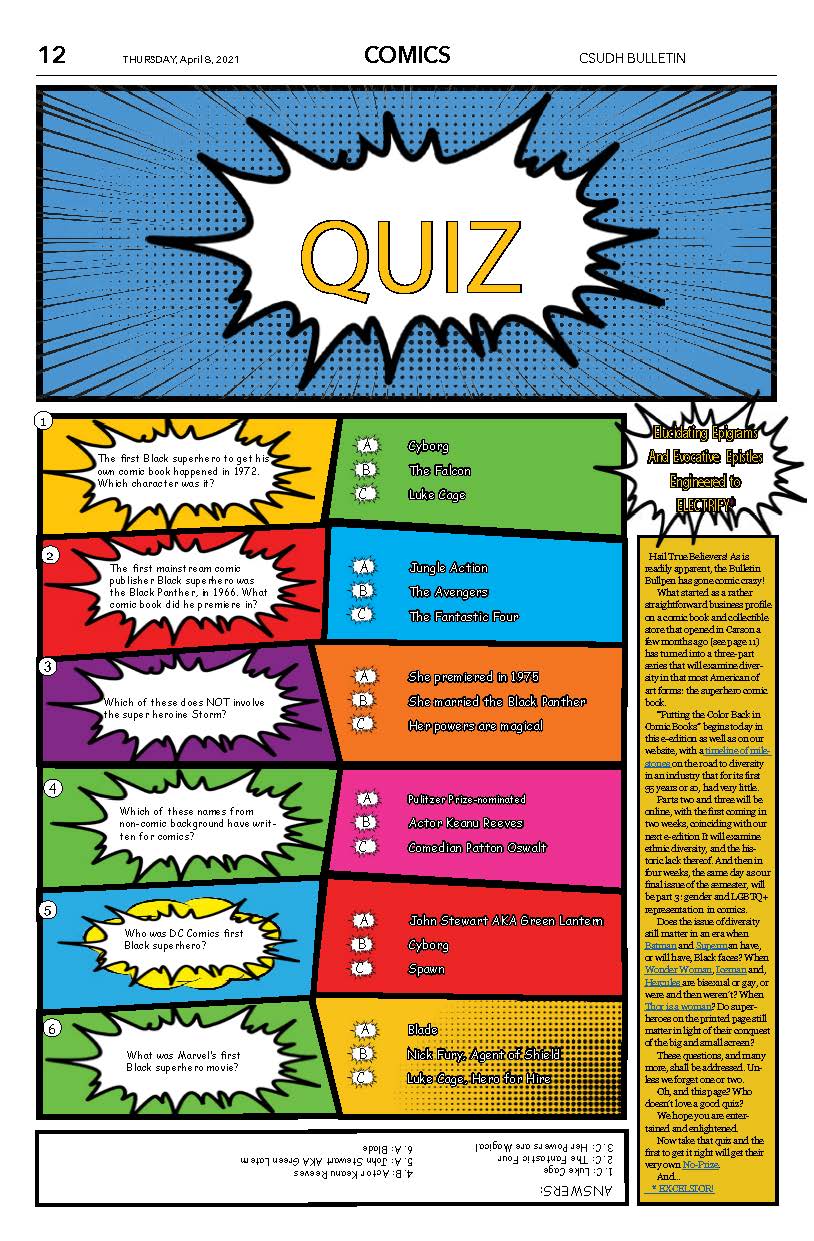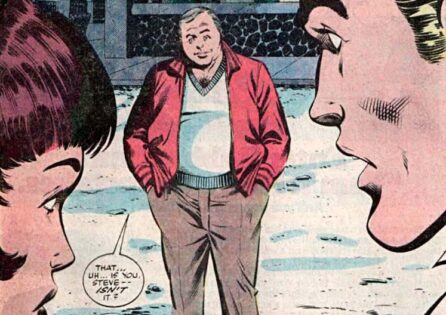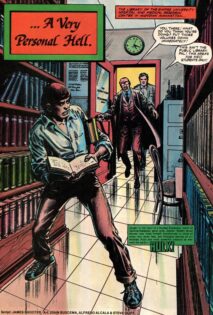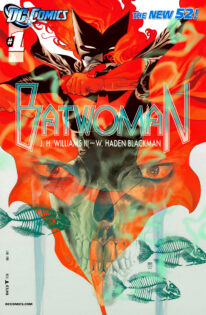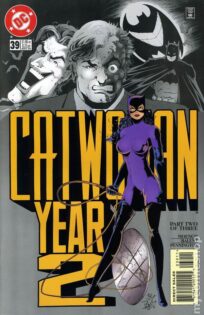Art designed by Joseph Witrago, from April 9 e-edition of CSUDH Bulletin
By Ben Gomez and Todd Matthews
Editor’s note: The Bulletin follows AP Style in terms of what to call this incredibly diverse community. And the AP Style Guide says LGBT or LGBTQ is acceptable in all references for “lesbian, gay, bisexual and transgender, or lesbian, bisexual, transgender and questioning and/or queer.” We choose to follow this style for consistency, and do not mean to marginalize or disrespect anyone us else under that very large umbrella who chooses to self-identify by any other term.
As famous days in history go, August 6, 1988 wasn’t particularly monumental–Jose Canseco becoming the 11th Major League Baseball player to hit 30 home runs and steal 30 bases in the same season notwithstanding.
But it would prove to be a landmark day in the history of LGBTQ representation in popular culture.
It was the third day of the 18th annual gathering in San Diego of a few thousand devotees of the geek sub-culture that would eventually dominate so much of the mainstream: the San Diego Comic Con. And while the convention had not yet morphed from what Vulture.com’s Chris Reed in 2019 described as a “humble jumble of cosplay, comic-book commerce, and superhero fandom,” into “Hollywood’s go-to ambush marketing platform for megabudget genre fare: horror, sci-fi, animation, and caped-crusader-oriented TV and film projects,” one niche panel introduced that year presaged how important the convention’s diverse audience base, and the contemporary focus on the importance of inclusion in the mainstream media, would become.
That 90-minute panel, Gays in Comics, featured eight comic book artists, editors and writers in a discussion moderated by a gay comics journalist, Andy Mangels. The topic? A “discussion of homosexuality as a legitimate subject in comics.”
That discussion has come a long way, as has that panel and representation of LGBTQ characters, and creators, in comics and other media. The panel is now the longest-running panel in the comics world, according to Mangels’ website. In 1999, it introduced a zine, Out in Comics that grew into Prism Comics, a nonprofit formed in 2003 that, according to its website, supports “lesbian, gay, bisexual, transgender, questioning, intersex, asexual and LGBTQIA-friendly comic books, comics professionals, readers and educators,” and works closely with San Francisco’s Cartoon Art Museum on the annual Queer Comics Expo.
In 2000, it partnered with the website, the Gay League, and hosted a gay comic fan reception and party. Two years later, it hosted two panels. Since then, while the main panel, renamed Out in Comics in 2017, remains the centerpiece, it has blown up; in 2019, the last comic-con held before the pandemic, Out in Comics/Prism Comics staffed three convention booths, presented the third annual Prism Awards, which recognize diversity in comics, and hosted an additional three panels: one devoted to new LGBTQ creators in the industry; another on whether a queer horror genre exists; and the third titled “Black and Queer in Popular Media.”
The growth of one organization at one event doesn’t begin to tell the whole tale of LGTBQ representation in comic books, specifically superhero comic books in the mainstream comics (i.e., Marvel and DC) industry, which is the focus of this five-part series. For while representation of the other three groups in this series (women, the disabled and people of color) has improved greatly this century in terms of more, fully developed characters as well as creators telling those stories, none compare to the percentage increase of LGTBQ representation.
Women superheroes (and, no, the first wasn’t Wonder Woman) have been around almost as long as the first superhero, an undocumented immigrant sporting a red cape and ankle boots and hosting a 1937 DeSoto touring sedan above his head, debuted in 1938 on the cover of Action Comics #1. The same with disabled heroes (Dr. Midnite, who was visually impaired, debuted in 1941). And while superheroes of color were a late addition to the costumed carnival (the Black Panther in 1966 was the first non-white one at either Marvel or DC), there was nothing forbidding companies from introducing them.
But for nearly 35 years, there was a defacto ban on any character who dared deviate from what many then, and some still today, consider the only “normal” sexual orientation. If those who identified with what used to be termed an “alternative lifestyle” felt marginalized, dismissed or muted in their everyday lives, they were all but invisible in the pages of comic books.
In 1954, in order to avoid being censored by government authorities, most major comics publishers signed onto the creation of an organization called the Comics Code Authority. The CCA would mandate that the publishers that created it would abide y a series of mandated rules , or a comics code. Those rules would cover how violence was depicted (even down to how much smoke could be seen emanating from the barrel of a gun); how police and other people in authority could be portrayed (never corrupt!); and even the source of superpowers (impossibly absurd scientific accidents, cosmic rays, radioactive spiders and hailing from another planet. OK; anything supernatural from invoking the devil not OK. Apparently, that was a thing in 1954…).
And, because this was America, and Americans were the ones so agitated about the harmful effects of comic books on the innocent youth of America that they began burning mountains of comics and clamoring for all kinds of laws that would seem to run counter to something called the First Amendment, why not toss that ultimate agitator—sex– into the already volatile mix?
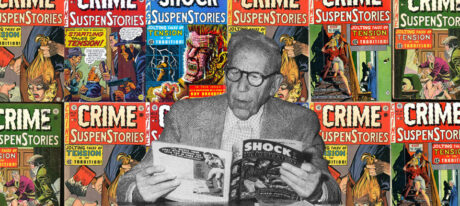
That was due in no small part to a renowned psychologist, Dr. Frederic Wertham who, strangely enough, though roundly vilified as the grand inquisitor of comic books, was also a strident critic of racial segregation due to his research that showed the harmful effects of segregation on children; some of his findings were used in the 1954 landmark 1954 U.S. Supreme Court case Brown vs. the Topeka Board of Education that ruled separate but equal school facilities unconstitutional.
But he was no friend of comic books. ” Hitler was a beginner compared to the comic-book industry,” was one of his more memorable hot takes, said during testimony before a 1954 senate subcommittee hearing on whether comic books inspired juvenile delinquency.
In that comment, he was referring mostly to the grisly horror and crime comic books that dominated the industry in the early 1950s. But even though the fortunes of superhero comics had fallen dramatically since the end of World War II (only three superheroes still retained their own titles, Superman, Batman and Wonder Woman) they were not spared Werthram’s opprobrium.
Dr. Frederic Werthram, author of “Seduction of the Innocent,” In tEstimony before a Congressional Subcommittee in 1954 exploring the possible effects of comic books on Juvenile Delinquency
Superman got off easy; all he did was promote Fascism. But Batman and Wonder Woman? Well, Bats was obviously in a homosexual relationship with Robin, something that would surely lead young males down that perilous route. Wonder Woman? Clearly a lesbian dominatrix. (to be fair, the Batman-Robin dynamic sets itself up for parody, and while there was plenty of bondage involving chains and ropes, any kinkiness in Wonder Woman stemmed far more from her rather fascinating creator than her sexual orientation, but more on that in part four of this series).
Long story short, most comic publishers were so worried that the anti-comic sensibility roiling the nation would adversely affect sales that they agreed to impose self-censorship by submitting all their comics to CCA administrators who would decide if they violated any of the rules, three of which pertained directly to sex:
- “Illicit sex relations are neither to be hinted at or portrayed. Violent love scenes, as well as sexual abnormalities are unacceptable.”
- “The treatment of love-romance stories shall emphasize the value of home and the sanctity of marriage.”
- “Sex perversion or any inference to same is strictly forbidden.”
That language could be interpreted any number of ways but, in 1954 terms like “sexual abnormalities,” and “sex perversion” were ringers for homosexual. (America was still 19 years out from that dreaded mental illness being officially removed from the list of illnesses that “impaired social effectiveness.”)
In effect, homosexuality, which was hardly prominent in comic books before the code was instituted, now no longer existed.
Which probably wasn’t too far from what decent, god-fearing folks yearned to believe in the first place.
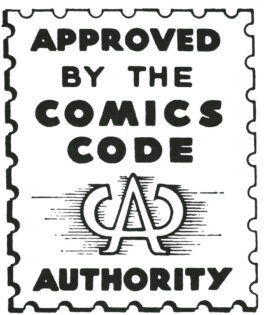
ee. 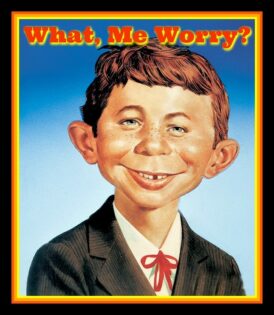
Although the code began loosening in the early 1970s around issues such as drug use—as long as the junkies were portrayed as helpless addicts in need of saving—it wasn’t until 1980 that any overt mention of homosexuality was broached, and that came in an issue of an oversized comic book, more of a magazine, starring a one-ton, green rageaholic, the Incredible Hulk.
And what a shitshow that was (for info on that comic, as well as a very detailed, quite enjoyable two-part series on the history of LGBTQ representation in comics up to 1988, see the aforementioned Mangales’ article, which begins on page 39 of the link. For a more recent look, see another two-part series written in 2014 by Alan Kistler.)
This isn’t to imply that all comics publishers avoided non-gender binary sexuality. The underground comix scene of the 1960s, though plagued by stereotypes, and the independent comics that began surfacing in the late 1970s and early 1980s, such as the groundbreaking Latinx series “Love And Rockets,” and the influential “Gay Comix,” which helped launch the career of Fun House creator Alison Bechdel, had more than their fair share of gay characters and situations. And Yuri and Yao in Japanese manga comics are merely one example of how much more progressive many other countries’ comic are in terms of sexuality.
It wasn’t until 1992 that Marvel officially outed its first gay hero, and in 2006, a reimagined Batwoman became the first openly lesbian character to get her own title, which was ironic considering the character was first introduced in the 1950s as a love interest for Batman’s alter ego Bruce Wayne to quell any speculation that he was gay.
But the past 10 years have seen a veritable explosion of LGBTQ superheroes and supporting character in both the DC and Marvel comic book universes, from the first openly trans character debuting in 2011 (though that is debatable), the first same-sex marriage ceremony in 2012, the first Latinx hero to receive her own title in 2017, Miss America, and in honor of his 80th anniversary, the first gay Captain America was unveiled just two days ago (Wednesday, June 2) in issue one of the “United States of Captain America.”’
And that’s not even mentioning the plethora of comics published outside the big two houses that focus on LGTBQ characters, including eight featured in graphic novels that will published over the next several months.
It’s been 33 years since that first gay comics panel at San Diego Comic Con. That’s a long time in many respects, but considering LGBTQ representation went from about five mph to 55 in that stretch and has caught up, or surpassed representation of other groups, it’s speeding along.
Not that it’s been a smooth ride, either for superhero comics or the other realms that superheroes have taken over. There have been plenty of
missteps, questionable decisions and controversies along the way. Lots and lots and lots of controversies, some intra-controversies between fans, some objecting to diversity in comics, some from comic fans objecting to certain creators being involved with projects because of past statements, Hell, even Archie Comics drew flack for introducing a gay character!
But whether it’s due to an increased realization of a responsibility that comics should more accurately reflect this country’s ever-increasing diversity, or a purely economic strategy to get new eyeballs, or a combination of those two factors and others, the reality is that there have never been more LGBTQ characters, or creators telling those stories.
And how can that be a bad thing?
“Diversity is legitimacy. It’s sincerity. It’s truthiness, to borrow a certain expression,” C. Spike Trotman, creator of the long-running webcomic Templar, Arizona, told Wired Magazine in 2015.” “Diverse storytellers mean diverse personal experiences being brought to the table, and more honest depictions of those experiences on the page in fiction. It’s not impossible for a creator to write about an experience they’ve never had; that would be a silly thing to say. But Cis Hetero White Male isn’t the default mode of human. Experiences influence creativity, and there need to be more than one set of experiences being reflected on the page.”
“There is something that is really powerful and amazing and beautiful about trying to see yourself in a story that isn’t at first glance a place you would normally see yourself.”
Dr, Tim Caron, Interim Dean, CSUDH College of Arts and Humanities
You’ll hear more from Carrie McClain, a CSUDH alumnus and writer for Black Nerd Problems , as well as Dr. Tim Caron, the interim dean of the College of Arts and Humanities and a comic scholar and historian of no small repute, in parts four and five of this series, but a couple of their comments seem very fitting to end this installment.
“Marginalized folks have always existed in comics, and in the real world,” “McClain said. “It matters to see them on the page and see their names as writers, illustrators, colorists, letterers and editors on the front covers of what we read as well,” McClain said. “In recent years, we’ve seen a movement in having a more diverse talent pool of parts of creative teams get attached to certain heroes, in the super hero world–when we think big comic book companies like Marvel and DC Comics. When is the last time you saw Black, dark-skinned queer women written by a Black queer woman? (Roxane Gay, writing the Dora Milaje in Black Panther: World of Wakanda mini series from Marvel).
“And even outside of those companies, seeing folks like my fave Vita Ayala who is non-binary, queer and Afrolatinx write charcters like Livewire (Vailiant), Zena, yes that warrior Princess (Dynamite) and now, the New Mutants for Marvel is super awesome to see.”
As far as dean Caron, he said that while his study of the industry doesn’t lead him to think that DC or Marvel will be in the vanguard of social change, he thinks their efforts at diversity are valuable for both those who were largely shut out of comics for so long, as well as those who weren’t.
“The superhero genre at its core is a very reactionary, politically conservative—maybe even fascistic—genre,” he said. “ The goal of the superhero is to restore order, to maintain the status quo…even if that status quo means that people don’t have clean drinking water, for instance. To me, this is why it’s important to talk about race and gender and sexual orientation in superhero comics. But, for me at least, that conversation is always going to end in frustration because of the ways that the superhero genre absolutely thwarts radical changes to society.
“(But diversity is)important (because) one: people get to see themselves in pop culture, but it’s also important for those of us who aren’t (a member of a marginalized group) to read those stories. To say ‘I’m not Black, but this story still speaks to me and I’m learning something about what it means to be Black, what it means to be queer, what it means to be Latinx.’
” There is something that is really powerful and amazing and beautiful about trying to see yourself in a story that isn’t at first glance a place you would normally see yourself.”
And not to finish dean Caron’s thought, but to finish dean Caron’s thought: Just maybe, by seeing ourselves in stories that aren’t about us, we can all start seeing each other, and recognize that while the destination is unknown, we are all fellow passengers on the same train heading there.

